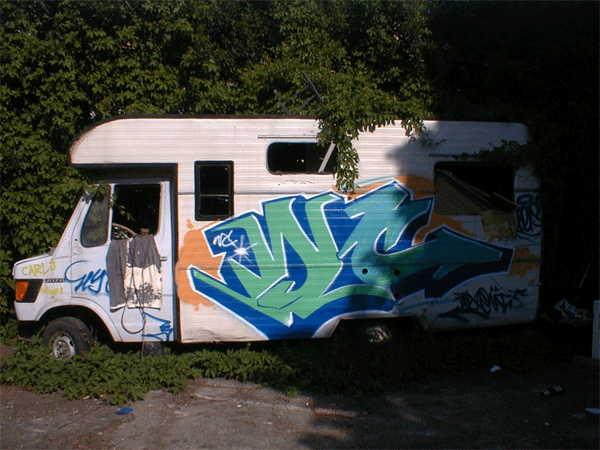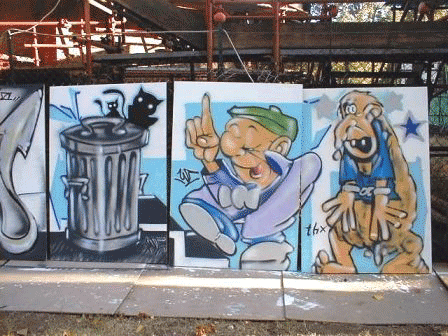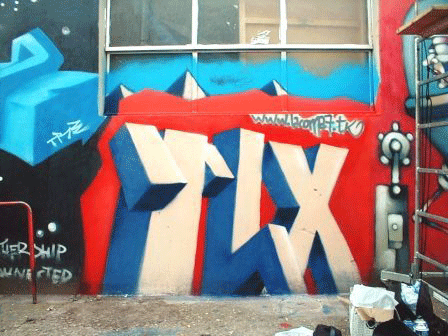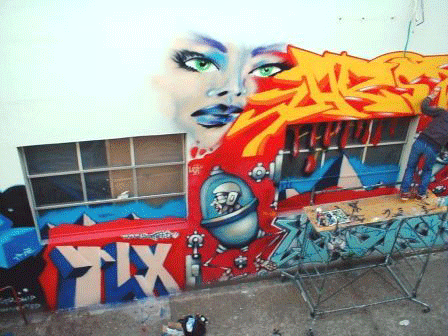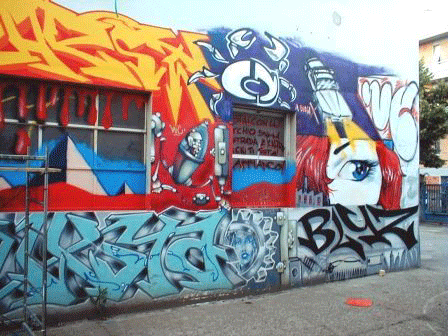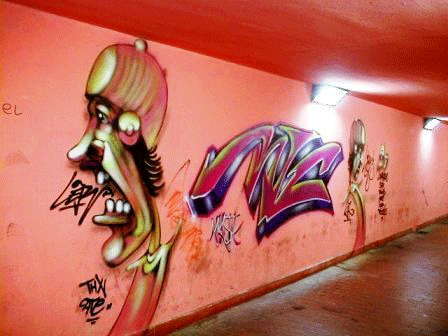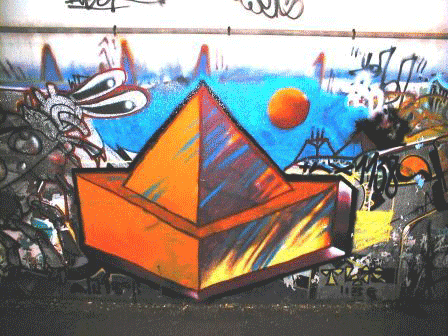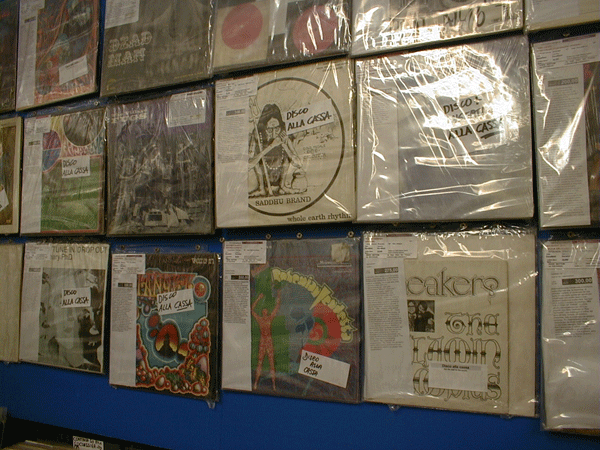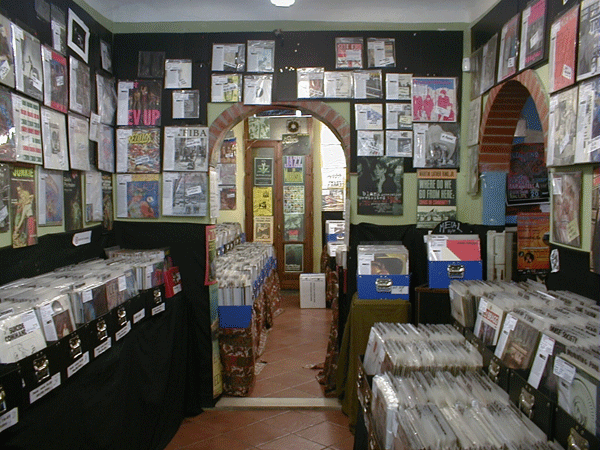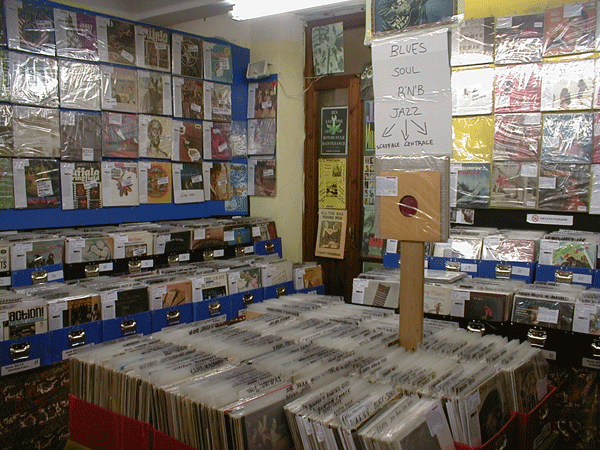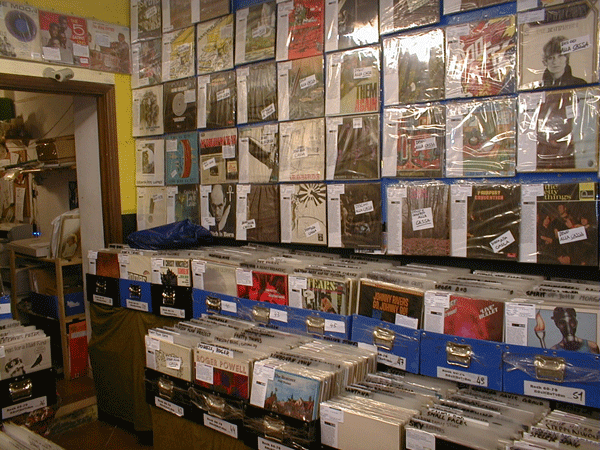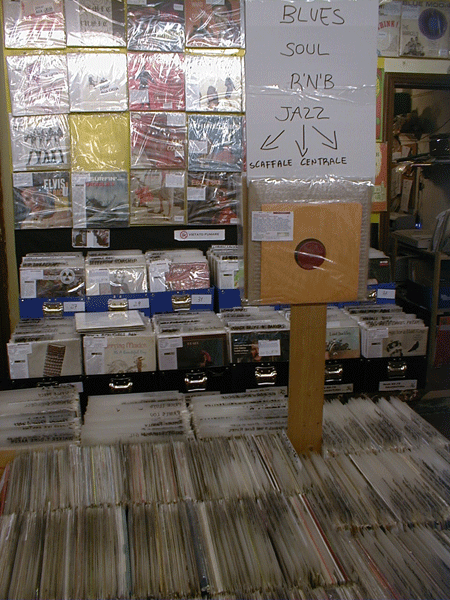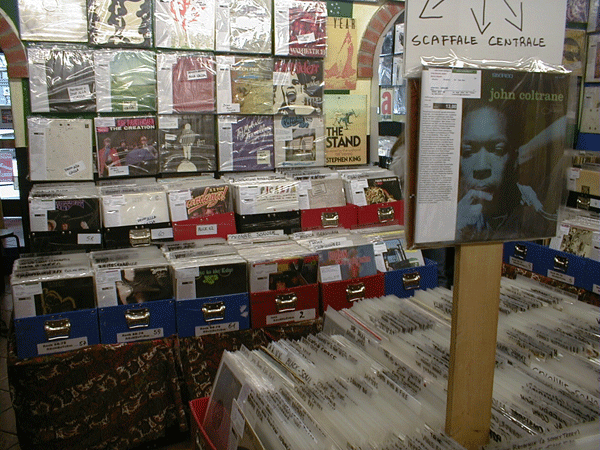Archive
Writerz Conexion 2004-2005 collection
Queste foto documentano alcuni lavori dipinti in vari luoghi a Firenze.
ded 2: EDUA – LER – AGENT – WAVE – DEOR – RAFFO – RAIS – JADO – RUN – KAT – WJM – VORTEX – A.N.D. – DIRTY HAND MADE – WC – ADR – ATD – SIR2 – RUFF – SNOOKIE – O. C. – NUMA – LC7 – RBC – M. C. – KORA – TAY – GRUFF – P. L.
xxx
bonus pic: la mossa dell’estate 2004
Breve storia del disco nella sua pratica concettuale v 1.1
Breve storia del disco nella sua pratica concettuale (versione 1.1)
fonte: http://www.timet.org/articles/uso%20concettuale%20disco.pdf
1877 – Thomas Edison inventa il fonografo; il principio della registrazione su cilindro permetterà l’avvio dell’arte fonografica come arte della registrazione del suono su supporto permanente;
1897 – Emile Berliner sviluppa il grammofono e la registrazione su disco piatto che permetterà una facile duplicazione della registrazione;
1903 – l’industriale statunitense del cioccolato Stollwerk inventa un giocattolo per bambini che riproduce musica incisa su solchi di cioccolata;
1918 – inizia a svilupparsi il giradischi elettrico;
1920 – è messo in commercio il primo disco flessibile in carbonio;
1922 – il compositore francese Darius Milhaud (1892-1974) inizia a sperimentare la variazione di pitch applicata a voci registrate su disco;
1923 – l’artista ungherese Lazlo Moholy-Nagy (1895-1946) riconosce lo sforzo senza precedenti dei rumoristi italiani nell’espansione della nostra percezione del suono. Moholy-Nagy espande i risultati delle loro intuizioni reinventando la funzione del disco. In un articolo su “Der sorm #7”, Moholy-Nagy sottolinea i fondamenti dei propri esperimenti: “Ho suggerito di trasformare il grammofono da strumento di riproduzione a strumento di produzione, così che su un disco sul quale non vi sia informazione acustica, possa esservene incisa”. Da “Informazioni su come manipolare i dischi e su come educare la gente a diventare da ricevitori a creatori”. Il lavoro di Lazlo Moholy-Nagy è importante sotto due punti di vista: per il suo contributo all’estetica del suono e per le relazioni che individua tra artista sonoro, performance, mezzo di registrazione e ascoltatore. Bypasserà i modi tradizionali di dare e far circolare concerti, dando concerti alla scuola del Bauhaus, utilizzando la tecnica di manipolazione dei dischi. Apre la strada a tuttaquella vasta area che verrà poi chiamata “concettuale” o “metamusicale”;
1930 – il compositore tedesco Paul Hindemith (1895-1963) e il compositore austriaco Ernst Toch (1887-1964) riciclano dischi per creare montaggi sonori; il lavoro di Hindemith è purtroppo andato perduto;
1931 – il direttore d’orchestra inglese Leopold Stokowski (1882-1977) porta ad una riduzione dello standard di velocità dei dischi, da 78 a 33 1/3rpm; è stato un pioniere nell’arte della registrazione con i suoi coraggiosissimi bilanciamenti delle sezioni orchestrali;
1934 – Theodore Adorno pubblica il suo saggio “La forma del disco”, all’interno della rivista 23. Nello stesso anno nel film l’Atalante di Jean Vigo un attore è visto suonare un disco con un’unghia;
1936 – il compositore francese Edgar Varese (1883-1965) compie esperimenti con dischi, suonandoli al contrario e variando la loro velocità;
1939 – John Cage (1912-1992) compone “Imaginary landscape #1”, per dischi manipolati, dischi di test frequenziale, piano e cembali;
1948 – il vinile rimpiazza il carbonio come materiale base per la fabbricazione dei dischi;
1952 – John Cage compone “Imaginary landscape #5”, per 42 giradischi missati casualmente;
1958 – primi esperimenti del danese Arthur Kopke, artista poi vicino al movimento Fluxus;
1963 – l’artista ungherese appartenente alla scena Fluxus Milan Knizak: “…nel 1963-64 ero solito suonare dischi sia lentamente che molto velocemente, questo cambiava la qualità della musica, creando nuove composizioni. Nel 1965 ho iniziato a distruggere dischi: li grattavo, vi facevo dei fori, li rompevo; ne emergeva una musica aggressiva, innervosente. Le composizioni potevano durare un secondo come all’infinito (come quando la puntina andava in loop su un difetto del disco…). Ho iniziato a dipingere i dischi a bruciarli, a tagliarli e ad incollare parti provenienti da dischi diversi. Il punto d’incollatura poteva rivelarsi una presenza ritmica, in contrasto con stati melodici… Una musica che non potrebbe essere trascritta, ma che era partitura in sé stessa, in quanto materiale capace di tramandare memoria… “ (tratto da “The broken music”);
1964 – un altro artista del movimento Fluxus, Robert Watts (1923-1988), racconta: “..ho realizzato una serie di dischi verniciati con lo spray per una performance Fluxus al Fluxstone di Canal Street. Venivano suonati dal pubblico, fino al momento in cui la musica non riemergeva… “ (tratto da “Extended play”);
1966 – l’americano Ken Friedman (1939), ancora Fluxus, realizza un disco completamente silenzioso;
1967 – James Brown introduce il primo break (assolo) di batteria in “Cold sweat” e riduce l’armonia della canzone ad un unico accordo. “Cold sweat” è la prima canzone funk della storia.
1968 – Tim Ulrichs realizza 13 dischi di carta vetrata a diversi gradi di ruvidità. Sono etichettati come “mono sandpaper records”.
1969 – John Cage compone “33 1/3”, un concerto per 12 suonatori di giradischi;
1970 – Thomas Schmit realizza un disco in legno, lo stesso anno Robert Watts racconta di aver realizzato dischi in diversi materiali, dalla creta al legno al metallo e vari tipi di plastiche. La maggior parte fu realizzata alla Rutgers University. I solchi venivano variati in profondità e in larghezza. Watts era interessato ai suoni ottenuti con i diversi materiali;
1972 – Arthur Kopke compone “Music while you work, piece #1”. 150 copie di un disco fatto di scotch e incollature, capace di generare rumori e musiche frammentate;
1972 – l’artista Braco Dmitrejevic (Bosnia, 1948) compone un disco di cartone con l’incisione eseguita da una biro. Viene esposto in una galleria;
1977 – Boyd Rice (NON) personaggio chiave del giro industrial noise di San Francisco (vedi RE/Search # 6/7: industrial culture handbook — http://www.researchpubs.com/books/ichprod.php), inizia esperimenti che porteranno alla produzione di dischi con solchi ad anello chiuso (loop) e fori decentrati. La condizione suggerita da Rice è quella di avere almeno tre dischi paralleli, ad alto volume; ha inciso a lungo per la MUTE Records;
1972 – il giamaicano Kool DJ Herc introduce il “Merry-go-round” (la giostra) nei suoi dj set, innovazione che lo porterà all’invenzione del breakbeat (una ripetizione o loop di un breve assolo di batteria). Successivamente porterà nel Bronx il suo soundsystem (the Herculords, un enorme impianto di riproduzione audio), per suonare all’aperto la sua collezione di dischi funk e rock (“Give it up or turnit a loose” di James Brown, “The mexican” di Babe Ruth, “Bongo Rock” e “Apache” di The Incredible Bongo Band, “It’s just begun” di Jimmy Castor, “Melting Pot” di Booker T and the MG’s ed altri classici breaks). Non suonerà i dischi per intero, ma sceglierà di riprodurre soltanto le parti degli assoli di batteria e percussioni in genere (breaks), e di ripeterli all’infinito usando due copie identiche di un lp. Così, con l’aiuto di tecniche poi diventate all’ordine del giorno come il “backspinning” (tornare indietro nei solchi del vinile fino al punto desiderato) o il “needle dropping” (abbassare la puntina in un punto specifico del disco, non all’inizio) dà il via di fatto al movimento Hip Hop, e l’arte di suonare i dischi –turntablism- avrà da allora grande divulgazione: i giradischi (turntables) diventano uno strumento vero e proprio; da artista concettuale, il deejay prende la strada che lo porterà a diventare musicista.
1978 – Grand Wizzard Theodore inventa la tecnica dello “scratching” manipolando il vinile, e mandando avanti e indietro un particolare effetto o una parte di un disco.
1983 – Grandmixer DST (ora conosciuto come DXT) è di fatto il primo turntablist: nel brano “Rockit” contenuto nell’album “Future Shock” di Herbie Hancock usa i giradischi come uno strumento, interagendo con la band. Nei primi anni ottanta Grandmaster Flash perfeziona il mixer e inventa un dispositivo che gli consente di preascoltare un brano di un disco nelle cuffie in modo da poter suonare due dischi a tempo. Un altro grande nome della Old Skool Hip Hop è Afrika Bambaataa, il cui stile ha influenzato largamente la prima generazione di turntablist. Già dalla fine degli anni settanta, cominciano poi le gare ufficiali di deejaying,dove i deejay si sfidano a duello su pratiche precedentemente schematizzate (routines). Tutto ciò rappresenta un modo per ufficializzare, migliorare e proteggere la nuova categoria. “The New Music Seminar in New York”, “The Vestax Championships”, e il “DMC” (worldwide Disco Mix Club championships) sono alcune delle organizzazioni più importanti e longeve per le deejay battles.
1982 – l’artista polacco Piotr Nathan (1956) incolla cavi sottili sulla superficie del disco per alterare il suono di superficie. Il risultato viene registrato e stampato su un disco in vinile. Lo stesso anno uno dei membri della rock band Wishbone Ash, attivo negli anni ’70, Martin Turner, fa costruire un disco di plexiglass con solchi specificamente incisi. Costellazioni di stelle di particolari date di nascita diventano eventi acustici. Ogni persona ha così la propria sequenza sonora;
1983 – R.P.T. Hayman concepisce un disco infinito che è leggibile solo da un particolare set di strumenti digitali. Il disco è comunque leggibile una volta stampato;
1985 – L’artista e deejay svizzero residente a New York Christian Marclay realizza il suo “Record Without a Cover”, vinile 12 pollici che non è dotato di nessuna protezione esterna. Il disco contiene alcuni dei suoni feticcio della cultura del vinile (il solco vuoto, la puntina che si abbassa, fruscii); i suoni che si stratificheranno sul supporto ne costituiranno storia ed arte.
1988 – Gli svizzeri Peter Fischli (1952) e David Weiss (1946) creano un disco di un particolare tipo di plastica. Suonabile con qualche rischio in un giradischi, il suond è lo-fi disco music. Nello stesso anno Christian Marclay distribuisce e confeziona dischi pestati in una galleria. L’opera ha il titolo “Footsteps”. la band inglese Coil realizza un disco con un lato vuoto. Ron Lessard produce dischi “concettuali”, il primo dei quali è di Andrew Smith, uno studente d’arte di Boston. Il suo lavoro poi distribuito dalla RR Records consisteva nel fornire coi dischi lamette, aghi, chiodi con cui alterare i dischi. “Metastasis” era il nome del progetto.
1989 – The Caroliners distribuiscono dischi con spazzatura di strada. Lessard produce una versione di “Colorado”, un disco tradizionale, con la traccia dei Architects Office distrutta dalla scritta “Fuck Architects Office”. RR Records produce dischi composti di cut-up di dischi precedentemente esistenti: “Montage”, di AMK.
1990 – La band The Linear Regressionists realizza il primo anti-compact disc. 50 copie di un CD silenzioso. I musicisti danesi Hater e Larsen realizzano “Oxygen is flammable”, un pezzo di plastica impacchettato in una piccola scatola. Le istruzioni suggerivano di versare acqua sul disco. Per loro il disco non è la musica, la suonabilità era ancora importante, anche se non attraverso un tradizionale giradischi. Dall’inizio degli anni ‘90 iniziano ad affermarsi le tecniche di montaggio di campioni e di produzione-riproduzione digitale del suono; il cd apre la strada al superamento del disco come deposito di prassi espressiva musicale, sia oggettivo che concettuale. Si afferma la via del campionamento.
1991 – L’artista sonoro americano Cole Harris produce pezzi rotti di dischi impacchettati in piccole buste. Ancora la considerazione del disco come notazione e suono al tempo tesso.
1992 – “Broken Light” del compositore Nicolas Collins (New York, 1954) è un concerto per quartetto d’archi, CD manipolati e un giradischi (edizioni Lovely Music).
1991/1992/1993 – DJ Qbert e Mix Master Mike vincono il 1° premio ai campionati mondiali DMC per tre anni consecutivi, rivelando al mondo quello che un “turntable musician” (musicista del giradischi) può fare: nuove tecniche di scratching (crabs, flares, chirps, scribbles, stabs, etc…), velocità ed espressività e originalità li hanno resi famosi in tutto il mondo. Tuttoggi sono due dei deejays più influenti nonchè gli ispiratori (insieme al pioniere DJ Steve Dee) del “beat juggling” (giocolieria con i beat) a livello mondiale.
1996 – viene fondata la ITF (International Turntablist Federation), una federazione orientata verso la definizione delle modalità dell’hip hop, che in breve diventa l’istituzione più rispettata e autorevole della scena del deejaying.
In tutti gli anni ’90 i dj di cultura dance apportano alle arti della manipolazione del disco in vinile la prospettiva concertistica: semplicemente trattati come elementi sparsi nella storia della musica discografica, ricollegati per una serata o per una compilation tematica; oppure usati sperimentalmente nella loro molteplice stratificazione, con variazioni e improvvisazioni rese possibili dal campionamento in tempo reale (esplorate le produzioni e i liveset dei deejay delle etichette inglesi Ninja Tune o Warp: Amon Tobin, Funki Porcini, TLS, etc. ), fino all’esecuzione di sofisticate partiture minimali, resa possibile solo con l’uso di dischi in interazione metronomica (ad esempio Andrea Parker ai giradischi riesegue partiture di Philip Glass).
Con il turntablism quindi, il deejay diventa di fatto un polistrumentista, un organizzatore di sorgenti liberate. Soprattutto negli ambiti vicino al jazz, affiancando al deejaying la pratica del campionamento (in macro, il vinile, in micro parti del vinile stesso, o con l’uso del campionatore stesso) ha aderito perfettamente agli organici di natura variabile del jazz, e all’uso dell’improvvisazione. Dall’ambito hip hop Bronx DJ Logic nel corso degli anni ’90 è sceso verso downtown ed ha incontrato i cenacoli del nuovo jazz; l’hip hop ha così conciliato la sua natura improvvisativa con le pratiche del jazz, instaurando nuove relazioni e rapporti fruttuosi.
Su questa scia, più vicini agli artisti concettuali che non al deejay hip hop, si collocano anche DJ Olive , Beth Coleman aka dj Singe (tutti e due presenti nell’istallazione “Bed Of Sound” del PS1 di New York) e più di recente, Raz Mezinai.
—
Testo riveduto e corretto da THX (4 ottobre 2010)
— fine del phile (revisione 1.1) —
Vinilemania!!!
Ho scattato queste foto da Rock Bottom – il mio negozio di dischi preferito a Firenze in via degli Alfani vicino al teatro della Pergola.
Qui posso sempre trovare tutto quello che voglio e anche di piu'!
Un saluto a tutte le amiche e gli amici che lavorano al negozio.
😉
Per info: http://www.rockbottomrecords.it
Il muro di Berlino
Cio' che resta del muro costruito attorno ai tre settori occidentali nella notte tra il 12 e il 13 agosto 1961 a Berlino Est, e' divenuto una esposizione permanente di graffiti dove centinaia di writers dipingono incessantemente.
L'estate del 2006 ho trascorso due settimane nella capitale tedesca. La zona adiacente al muro che costeggia il fiume Spree e' un agglomerato di bar, locali notturni (c'e' anche una piccola pizzeria napoletana!) che sorgono su quella che un tempo fu la "terra di nessuno": una striscia di terra larga cento metri cinta dal muro su ambedue i lati, est e ovest (in realta' i muri erano due che correvano paralleli) lungo la riva del fiume. Oggi rimangono solo circa uno o due kilometri di muro infestati dai graffiti. Ho cercato di fotografare il piu' possibile ma l'atmosfera di quel luogo e' indescrivibile.
Le foto sono state scattate a meta' agosto del 2006.
La notte del 6 agosto per il mio compleanno sono entrato in uno di questi locali techno adiacenti al muro di cui non conoscevo neanche il nome, e alle 4 del mattino con mio grande stupore sono balzate fuori da una porta 5 stripper da capogiro vestite (o forse dovrei dire spogliate!) di tutto punto che hanno intrattenuto il pubblico per una mezzora su di un piccolo palco di legno stile freakshow degli anni '20. La pista da ballo era gremita. Sono rimasto li' per circa un' ora e mezza. Un compleanno bizarro! La zona fra Kreuzberg e Friedrichshain , precisamente fra la stazione ferroviaria Ostbahnhof e la Schlesische Tor, e' ancora una linea di confine, un confine psicogeografico. Sempre in zona vicino alla stazione ferroviaria di Warschauer straße c'e' anche un bar con cinema all aperto chiamato Freiluftkino Insel im Cassiopeia (http://www.freiluftkino-insel.de/ – vedi anche http://www.skatehalle-berlin.de/) che proietta vecchi film Blaxploitation, anteprime di film hip hop e classici del cinema come Taxi Driver il tutto in pellicola 35mm. Ho potuto assistere alla proiezione di "Coffy" di Jack Hill, con Pam Grier (1973) e "Dave Chapelle's Block Party" con Dave Chapelle, Common, The Roots, Erikah Badou, Kanie West, DJ A-Trak, Mos Def, The Fugees, Talib Qweli (2005). L'arena e' fornita di sdraio stile "tipo da spiaggia" molto comode e ci sono molte coperte di lana (molto pulite!) per chi aveva freddo.
Inoltre venivano serviti degli ottimi drink e birre in bicchieri di vetro.
Mercoledi' 25 aprile 2007 ore 23.23
Per vedere tutte le foto clicca sul link qua sotto:
GRAFFITI/”WRITING”: AN “OBTRUSIVE” ART
Dalla pagina http://people.freenet.de/graffitiforschung.de/OBTRU.htm
GRAFFITI/WRITING:
-AN "OBTRUSIVE" ART-"
Published for the Hip-Hop Project of "Forum Kultur" at Poznan and Opalenica,October 2003
C:Copyright by.A.THIEL (2003)
URL of these pages:
http://people.freenet.de/graffitiforschung.de/OBTRU.htm
IN MEMORIAM ET HONOREM OF:Erik ROTHEIM (Norway) and Edward H.SEYMOUR (US) that triggered "creative avalanches" by their invention and adaption of spraycans.
Special thanks to Bernard ZOLYNAK for the invitation.
INTRODUCTION:
Since 30 years we can track the developement and growth of a GLOBAL HIP-HOP,creating chances to come to know each other and meet,in order to mutually discuss today`s state of being,future chances,so to say a summing up of psycho-social state of the arts,the analysis of the environment and possible psycho-toxic influences threatening mankind with extinction.That young people dare to express themselves causes much irritation and despite all repressive tries (so far) the only outcome has been the creation of a sector of "graffiti-as-business" already selling an annual $ 50 billion,with rising tendency since 30 years despite all threats "to definitely put an end to the visual vandalism" up to statements calling graffiti "visual terrorism" and the rest of psychological warfare against "writers" globally.Please also note US "billion" equals European "Milliarde".
OBTRUSION (1):
Wort with Latin origin="obtrudere",meaning forcing you and your activities onto someone,gaining and desiring other person`s attention,acceptance by various means also against other persons desire.
OBTRUSION (2):
All arts work by "obtrusion" via all of your senses (remember I said we have much more than 5……...) once you come within the very art`s reach,realm of influence,you may be moved,maybe even without your notice influencing also our unconscious.
DEFINITION:
Art that works as obtrusion uses specific techniques.Many of them never are being reflected by us,like architecture and town-planning.The way a house is being built-size,material etc.- and the outlines of a community OBTRUDE on you even if you never think about the forms being used here.If you ever have been in a palace or a governmental building,in most cases sheer size and the masses of material being aimed at creating a feeling of inferiority,intimitating people.The "German Fuehrer`s" headquarters at Berlin were of such planning,you had to walk miles before even coming closer to him.But all that because already being integral part of cultures is seldom considered as OBTRUSION,it is the "newcomers" in the art-sector (also because the old parts do not want to share power and influence) that must use lots of energy,spectacular Activities and aggressive techniques to also become an attractor,eyecatcher and being taken notice of.
WRITING/GRAFFITI AS OBTRUSIVE ART:
Having explained at various parts that graffiti always also developed along the axis of technical innovations,meaning new Signing,writing techniques and tools also permitted the re-invention of graffiti various ways and permit a cultural adaption,last developemental step here was the use of the (1926 by Erik Rotheim,Norway) invented SPRAYCAN,that in 1949 was adopted in the US (Edward H.Seymour) staring with aluminum-color,triggering a "color-revolution" that,around 1965 caused the "explosion of graffiti" in urban slum and ghetto areas known now as "WRITING (AMERICAN STYLE)" along with several other SOCIAL INVENTIONS RAP and BREAKDANCE fusing new (now already global) youth culture known as HIP-HOP.Young people (writing is a male way of expression,99%) such as therefore take their liberties and use already existing walls as their roaming spaces and playgrounds get scarcer all the time,offering them little other real challenges."WRITING" today has-globally-become the accepted SYMBOLIC AGGRESSIVE (color,form,outline and content) technique within known TRANSITIONAL RITES during COMING OF AGE,where young people in all countries and cultures have to undergo specific exams,transgression of some rules included and also expected to finally gain manhood and become accepted adults.
This very much conflicts with the also existing negative developemental trends to keep people in a permanent and perpetual state of "petrified adolescence",the creation of a ongoing state of needs feeding the global capitalist system anabling the sale of also goods not really helpful and necessary,the many gadgets of a "surplus-production" bent on the creation of er-satz-needs of all kinds permanently promising something wonderful never fulfilling the promise causing a "thirst" that never can and will be quenched.Now young people normally being very much aware what is being done to them "smell that rat" and start counter-measures expressing discontent via writing,rap and breakdance.
OBTRUSION VS.PERMISSION:
One of the most cited statements:"Only graffiti done by permission can be considered art" sounds very "natural" but if you take a short pause and think about it you also may come to notice that IF that would be true art only created by permission MOST art would never have been created at all.It would miss the slightly chaotic aspect of art being a little rebellious and coming into existance also as a counter-reaction to "normality" if that "normality" becomes "dead",boring and/or even psycho-toxic like we know from dictatorships and police-states.Then we have a "Social Realism" where pictures and statues done during 3.Reich and those from Russia under Stalin`s rule look so much alike.This means arts without liberties Decay into lick-spittling and propaganda.This means now we already may know arts always have to RE-INVENT and RE-CREATE themselves,adopting and adjusting to chances in societies still being able to indicate the "hot-spots" of their Times.Modern graffiti,known as "writing" is one of the artistic answeres to actual problems of our environment.No wonder They cause so much controversies and resistance from any by the "establishement".
SPECIFICS:
Central question being HOW COME an international cohort of young males being so dedicated on OBTRUDING reflecting psycho-social goings on of and in modern,complex societies.a society,and the answer is we see via graffiti/writing a MIRRORING PROCESSNONE ASKS persons being MARGINALISED,so no wonder such persons (and others from other societal background=classes being afraid to face comparable "futures") do what they do WITHOUT ASKING (permission),doing to rest of society what they experienced before.A tiny international cohort manipulating the GLOBALIZATION selects millions of persons meaning throwing them onto the "unemployment piles".This input invites a feedback,and now surfacing on outer walls,those manipulating "reality" start complaining.
OBTRUSION AS COUNTEREFFECT TO MARGINALISATION:
If you feel you`re being marginalized,your behavior may become obtrusive,or even must.We should not forget where "writing" originated in the ghettos and slums of urban spaces of US megacities,where a "silenced mayority" being psycho-socially already aborted.must survive.We also should keep in mind some of first "writers" statements understanding their desperate situation:"IF we want to become 20 and survive,where guns are cheap and easy to get,we must create a competitive system,where only personal ability counts,and exchange weapons for art!"
Or,as one German "writer" From Munich later said:
"I want to give something back,and feel as a servant to society".
That much to the accusations writers would be "visual terrorists" and "vandals".
We watch in all modern,complex societies a growth of persons without jobs/work,and at same time also a lessening of free roaming spaces for young persons and children,a lack in playgrounds where next generation may be among themselves by a process to sell all available public space and thus turn it into PRIVATE PROPERTY.None seems to care Where children now may play……This aspect of an experienced reality of an INIMICAL ENVIRONMENT shows an aspect of a process of PSYCHO-SOCIAL ABORTION seldom discussed about,and contains a dangerous aspect,the PSYCHO-TOXICITY of these MARGINALIZING processes.To be made an "UN-PERSON" can be deadly like We already know that UNEMPLOYMENT also kills-in the long run-via realizing that you are NOT NEEDED/WANTED ANY MORE.No human being can live this way……
LITTERATURE:
ANONYMUS:"Hip-Hop Lexikon",AT:
http://www.beepworld.de/members4/godfather151984/index.htm 2003
ART CRIMES: http://www.graffiti.org 2003
BOSMANS,B./THIEL,A.:"Guide to graffiti-research",Gent 1995,ISBN90-802903-1-9
JACOBSON,S.:"International dictionary of aerosol art",AT:
http://www.djingis.se/memb/ovre/aerosolart/aerosolart 2003
KESAB(Eds.):"Graffiti-research project",AT:
http://www.kesab.asn.au/graffiti 2002
KREUZER,P.:"Das Graffiti-Lexikon",Muenchen 1986,ISBN 3-453-35068-5
LONDON ASSEMBLY GRAFFITI INVESTIGATIVE COMMITTEE:"Graffiti in London",London 2002,ISBN 1-85261-366-1,AT:
http://www.london.gov.uk/aproot/assembly/index.jsp 2003
PHILLIPS,S.A.:"Wallbangin`,graffiti and gangs in L.A."Chicago 1999,ISBN 0-226-66772-3
THIEL,A.:"Einfuehrung in die Grafitti-Forschung/introduction to graffiti-research",Kassel 1977 ff (34 parts),CONTENT OVERVIEW",AT:
http://users.aol.com/archive1 1995
THIEL,A.:"London:graffiti-prevention",AT:
http://people.freenet.de/graffitiforschung.de/LONDON.doc 2001
THIEL,A.:"London Asssembly;graffiti in London,a critique",AT:
http://people.freenet.de/graffitiforschung.de/london.htm 2002
THIEL,A.:"Modern iconoclasm:destruction of graffiti/writing",AT:
http://people.freenet.de/graffitiforschung.de/ICONOCLASM.htm 2002
THIEL,A.:"An internet-textbook of graffiti-research",AT:
http://people.freenet.de/graffitiforschung.de/KSurl.htm 2003
THIEL,A.:"Urban graffiti:the social background indicators (for:LONDON ASSEMBLY)",AT:
http://people.freenet.de/graffitiforschung.de/LOND-ENVIR.htm 2003
THIEL,A.:"Keyword-overview (15 parts of "Vocabulary of graffiti-research)",AT:
http://people.freenet.de/graffitiforschung.de/KEYwd.htm 2003
VAN TREECK,B.:"Das Grosse Graffiti-Lexikon",Berlin 2001,ISBN 3-89602-292-X
http://www.schwarzkopf-schwarzkopf.de
INFORMATIONS:
You may contact me anytime:
Axel THIEL Dipl.Supervisor,Dipl.Sozialpaedagoge
Bluecherstr.5 Intl.work-group on graffiti-research
D-34123 KASSEL ARCHIVE1@aol.com
Germany
Tel:0561-55642 Cellular phone:0177-5083847
KASSEL GRAFFITI-ARCHIVE:100 000 documents
BIBLIOGRAPHY(4.): 32 000 entries
STUDENTS may use KASSEL GRAFFITI-ARCHIVE for FREE,but must donate a copy of their exam-products to Archive to help next students.So far 2 000 contacted me (and another 8000 persons and institutions) during 28 years.Make an appointment before you come to be shure I am present.
Altre pagine a proposito del graffiti writing all'indirizzo
WHAT IS GRAFFITI?

*WHAT IS GRAFFITI?*
*The word "graffiti" is derived from the Latin word "graphium," which
means "to write". It was originally used by archaeologists to describe
drawings and writings found on ancient buildings and monuments in
Pompeii, Egypt and in the Roman catacombs.
The most basic definition of the term "graffiti" is "inscriptions or
drawings scribbled, scratched, or sprayed on a surface, originally as
inscribed on ancient walls."
*THE HISTORY OF GRAFFITI*
*Although it has been proven that graffiti evolved during ancient times,
it did not play a significant role in society until the mid-1960's.
Therefore, it will be easier to comprehend the history of graffiti by
separating certain time era's dating from 1966 to the present time.
*1966-1971- The Evolution Begins*
Graffiti made a huge impact in society, when it was used by political
activists to rebel against their country's government. However, it also
made an impact in Philadelphia, Pennsylvania, where many argue it
originated. Gangs would use graffiti as a way of marking their
territory in many communities. As time progressed, graffiti expanded to
other American cities, most notably in New York City. This is where
graffiti artists began to be recognized individually, and not through
the gang or crew they were associated with. Cornbread and Cool Earl
were the first artists to be known in New York City.
*1971-1974- Competition Through Tags*
During this time, more and more people were becoming aware of graffiti
in New York City. Once Cornbread and Cool Earl made their names known,
many other artists began to break through. TAKI 183 was one the first
artists to write motion tags on subways. His real name was Demetrium,
but had adapted the title Taki in his neighbourhood. He lived on 183rd
Street, and was a messenger who used the subway frequently. As a result
of his unusual tags, and the street name he acquired, he gained much
popularity throughout the city, even being featured in a New York Times
article.
TAKI 183 is credited as being the one who began the competition among
graffiti artists. CAY 161, JOE 136, JULIO 204, and FRANK 207, and TREE
127 were just some of the many artists who competed in NYC. Since their
tags were being seen by almost everyone, their individual goal was to
have the most tags on the subways, trains, cars, and buildings in the
city. They also tried to make their tags as unique as possible, so they
could stand out from the rest.
*1975-1977- 'Throw Ups' Are Created*
"For the most part innovation in writing hit a plateau after 1974. All
the standards had been set and a new school was about to reap the
benefits of artistic foundations established by prior generations and a
city in the midst of a fiscal crisis." The 'throw up' style was a way
of making a letter. It was outlined, though barely filled in. 01, 167,
IN, IZ, DY, FL, PI, and TEE were best known for their 'throw ups'. This
breakthrough added to the already aggressive competition that was
established within the art of graffiti.
*1978-1981- Graffiti Expands to Overseas*
At this point, the competition between graffiti artists was at its
peak. It just so happened, that also during this time, the Metropolitan
Transit Authority began to enforce the elimination of all graffiti
throughout New York City. In the early 1980's, American graffiti
artists began to head overseas, where graffiti was now becoming better
known, and not yet illegal.
*1982-1985- The Implementation of Laws*
Due to the growing rate of drugs, guns, and violence in the streets,
laws were being implemented to make cities become more safe. One such
law was to restrict the selling of paint to all minors. Also, train
yards and lay-ups were being more heavily watched, since they were known
to be the 'ideal' graffiti areas. The concept of graffiti removal was
also put into place, which eventually led to the decrease in graffiti
artists.
*1985-1989- Graffiti's Darkest Era*
By mid-1986, the Metropolitan Transit Authority took full control, by
having full-time security on the subway system. This had a positive
effect on society, in that the violence decreased, but it also led to a
drastic decrease in the amount of graffiti artists left.
*1989-Present Time- The Clean Train Movement*
"On May 12, 1989, the MTA 'declared a victory over graffiti.' They
effectively removed all marked cars from running, activity which became
known as the Clean Train Movement. Many writers believed that tagging
on trains meant that you were a 'real' writer, which tagging on walls,
freights, and scraps meant you were 'fake.'"
More recently, graffiti artists have been gaining more recognition for
their work, as much as the criticism is still in effect. Graffiti is
being featured throughout various media sources, and continues to be a
popular artform in urban culture.
*VIRTUAL COMMUNITIES*
Due to the consistent growing population of the internet, graffiti has
become more and more recognized by society. Since graffiti is a complex
art form, most internet sites depict a specific genre dealing with
graffiti. Such genres include websites pertaining to *graffiti crews*,
*graffiti equipment*, *the history of graffiti*, and *graffiti writers*.
*Graffiti Crews: *These sites are the homepages of various graffiti
writer crews. Sites differ depending on the crew, but most include a
brief history of the formation of the crew, biographies of its members,
and photo galleries of their work.*
*"*Disruptiv.com* <http://www.disruptiv.com/>* *is a site which
showcases the work of members of the Disruptiv collectiv. It features
New Zealand based artists, and also features collaborative works with
Daim, Can2, Loomit, Tasek, Seak and many others.
*VMD70S.com* <http://vmd70s.com/> is the official site of the VMD70S
crew from Milan, Italy. It contains hundreds of photos, as well as
several videos and links (Directory, 2003)."
*Graffiti Equipment*: These sites are of webpages the sell graffiti
equipment to the public, directly over the internet.
"*Graffsupply.com* <http://graffsupply.com/main.asp> is a site selling
graff supplies (caps, videos & magazines). They also sport a graffiti
picture database consisting of over 3413 pictures from 642 writers.
*BeatBreaks.com* <http://beatbreaks.com/index2.html> is a very large
net-store selling almost everything from battle records and videos to
graffiti supplies and books (Directory, 2003)."
*The History of Graffiti*: These sites focus on a detailed overview of
the history of graffiti, which dates back to the mid-1960's.
"*at149st.com* <http://www.at149st.com/history.html> focuses on the
period of 1976-1981 in the New York City graffiti scene. On this site,
you can find a writer's list, a crew list, and a historical overview
with photos.
*HipHop-Network.com*
<http://www.hiphop-network.com/articles/graffitiarticles/historyofgraff-arpone.asp>
is an all-around site focusing on all four elements of hip hop
culture.through the medium of video. This site also contains an
excellent archive on written material on the history of DJing, MCing,
graffiti writing, and b-boying (Directory, 2003)."
*Graffiti Writers*: These sites display the works and talents of
individual graffiti writers.
*Loomit.de* <http://www.loomit.de/> is the website of the very talented
graffiti writer, Loomit. It displays his creations on walls and
canvases, as well as the creations of his favourite graffiti writers.
*Daim.org* <http://www.daim.org/> is another graffiti writer website,
which displays his various styles, murals, canvases, sculptures,
etchings, animations, sketches (both colour and black & white), glasses,
and photos. It also features a brief biography, including interviews
and newspaper articles.
*GRAFFITI AND INTERACTIVITY*
Dating back to the 1960's, when graffiti first began to make a scene in
society, only those who were directly associated with it (ie. graffiti
crews and writers), could interact with eachother. However, the
internet has used the art of graffiti to give all online users a chance
to interact with eachother.
One such way that graffiti and interactivity co-exist is through
"*Graffiti Boards*." Many online sites have used graffiti boards as a
way of having their site's guests interact with them, as well as
eachother. Graffiti boards are simply a place where users have the
oppertunity to give their opinion on a particular topic. They have the
chance to relate their opinions to other user's postings, or even with
regards to supporting or arguing against what has been said on the
actual website.
One example of a popular graffiti board, which is online, is seen *here*
<http://www.pbs.org/art21/edu/student>. This particular site is where
users have the chance to state whether or not they feel graffiti is art
or vandalism.
Another way in which graffiti has become interactive is by having
graffiti writers and crews compete in offically sanctioned *Graffiti
Competitions*. Such competitions are done to give artists the chance to
expose their talents to other artists, and compete for brags as to who
is the best. Contestants have the choice of working on walls or
canvas. For most competitions, the winning contestants are able to
showcase their finished graffiti pieces over the internet. They have
become very popular across Europe, and are only now spreading over to
some North American cities.
*HOW IS GRAFFITI AFFECTING TECHNOLOGY?*
Graffiti is constantly affecting breakthroughs in technology through
various forms. Some were mentioned above, under the headings *VIRTUAL
COMMUNITIES *and *GRAFFITI AND INTERACTIVITY*. Just to summarize, the
affects that graffiti has had on technology are seen through websites
that give online users a chance to purchase graffiti equipment over the
internet, as well as through graffiti boards, which have taken websites
by storm.
However, graffiti has also affected technology by initiating
breakthrough inventions for the purpose of destroying actual graffiti.
Two examples of such inventions are given below:
*The Anti-Graffiti Painting Vehicle*
<http://www.nyc.gov/html/nograffiti/html/technology.html>
"The New York City Department of Sanitation has designed and developed
in-house a self contained mobile anti-graffiti unit. This unit is
utilized by the department to battle the widespread problem of graffiti
throughout the city, it has the ability to clean, prepare, and custom
paint the site to its original color (Vehicle, 2003)."
*The Anti-Graffiti Powerwashing Vehicle*
<http://www.nyc.gov/html/nograffiti/html/technology.html>
"The New York City Department of Sanitation has developed a
self-contained mobile graffiti removal unit. This vehicle is used by
the Department to chemically remove the widespread problem of graffiti
throughout the City (Vehicle, 2003)."
*HOW IS TECHNOLOGY AFFECTING GRAFFITI?*
Technology should be given much credit to the dramatic increase of
exposure that graffiti was given, after the internet was developed.
Some examples of how technology has affected graffiti are stated above,
under the heading *VIRTUAL COMMUNITIES*. To recap, the internet has
given graffiti crews and writers the oppertunity to expose their talents
to the world through the internet. Also, more and more people have
become aware of the history of graffiti through many websites on the
internet.
Another way that technology has affected graffiti is through spreading
more awareness of controversies surrounding graffiti. One such
controversy that has caught the eye of many internet users is the debate
as to whether graffiti is art or vandalism. Thousands of sites use
message boards to obtain the opinions of online users with regards to
this debate. One such site was given under the heading *GRAFFITI AND
INTERACTIVITY*, which can be seen *here*
<http://www.pbs.org/art21/edu/student/>. Another graffiti board
pertaining to the debate is seen *here*
<http://pub137.ezboard.com/fyouthexpressions10240frm9.showMessage?topicID=27.topic>.
This controversy has also led to being a feature story on many
television programs/stations. An example of this is seen on *CNN.com*
<http://www.cnn.com/US/9603/graffiti_art/>. Also, many editorials by
various jounalists, have been written, including an article *here*
<http://www.abbotsfordtimes.com/113202/news/113202nn8.html>, written by
Christina Toth.
Another way in which technology has affected graffiti through the
internet, is by allowing anti-graffiti program's/organization's sites to
be created. This has led to more people becoming aware of the supposed
down-falls that graffiti exhibits. They are usually formed by the
government of a particular city, and are extremely common in most US
cities. Some examples of such websites are given below:
*Anti-Graffiti Program
City of San Jose* <http://www.ci.san-jose.ca.us/antigraf/Program.html>
*Mayor's Anti-Graffiti
Task Force* <http://www.nyc.gov/html/nograffiti/home.html>
*DNS Anti-Graffiti Program*
<http://www.ci.mil.wi.us/citygov/dns/main/sections/antigraffiti/antigraffitiprogram.html>
*BACK TO HOMEPAGE* <http://www.geocities.com/laeeque1650/>
Rammellzee – intervista 1984
Rammellzee
Intervista di Maurizio Torrealta
testo tratto da Frigidaire N.38 – Gennaio 1984
Con Rammellzee l’intervista si è rivelata parecchio difficile: la sua ricerca sulla grafia ha influenzato anche il suo linguaggio quotidiano, producendo una catena di associazioni fonetiche e invenzioni gergali “letteralmente” impossibili da tradurre.
Forse in questo ha giocato anche la sua esperienza di cantante “rap”, ed ha avuto senz’altro un certo peso la sua appartenenza alla setta islamica dei “Five Per Cent”, che lo ha influenzato a tal punto da divenire un enigma vivente, una sorta di rebus parlante (ovviamente non ci prendiamo la responsabilita’ di una traduzione letterale di quello che verra’ detto da Rammellzee).
Come hai deciso di cambiare il tuo nome di battesimo in Rammellzee? (Rammellzee è figlio di padre italiano e madre nera)
“Rammellzee è una equazione, una equazione militare, Ramm più l’elevazione di x alla z, io sono un dio, un dio divino” (i membri del gruppo musulmano “Five Per Cent” usano definirsi come dei divini, ndr).
Puoi descriverci il tuo lavoro artistico?
“Il mio lavoro artistico è l’elevazione della conoscenza dal livello di wild style al suo livello conclusivo di simboli distruttori, meccanismi armati medioevali; questa operazione deve essere conosciuta anche come PANZERISMO ICONOCLASTA o Futurismo Gotico che altro non è che il wild style corretto. Nel 1582 il tredicesimo papa fece sparire dieci giorni dal calendario, ricompariranno nell’anno duemila; dal 400 al 1974 i numeri, le lettere ed altri simboli universali della malattia culturale sono stati nelle mani dei calligrafici e si trovano in uno stadio inconscio di evoluzione panzeristica.
Lo sviluppo a bolle e lo scoppio emozionale è avvenuto dal 1974 al 1979, un periodo di guerra dove la conoscenza si formava da sola nel buio dell’UNDERGROUND. Dal 1980 al 2000 si sviluppa la separazione tra Wild Style e Panzerismo.
Ricapitolando, il bomberismo è uno stile basato su cifre e non è armato (ma potrebbe esserlo); il wild style è in parte basato su bolle a bombe, inconscia presenza del panzerismo; mentre il panzerismo iconoclasta, o futurismo gotico, basa la conoscenza in modo non emozionale e non svela nessuna identità interna, mostra complete strutture in dettagli di dettagli di lettere stilizzate come carri armati. Tutto questo PER DIMOSTRARE CHE LA VECCHIA RACCOMANDAZIONE DELLA MAMMA “LE PAROLE NON POSSONO FARTI DEL MALE” É FALSA”.
In un tuo pamphlet descrivi le trasformazioni a cui hai sottoposto le lettere del tuo alfabeto. Puoi spiegarci per quali ragioni preferisci una lettera ad un’altra?
“Le lettere sulle quali lavoro sono principalmente la K, la V, la W, la X e la M. Per queste ultime il valore dell’ informazione è cinque, infatti la V è il numero cinque romano (ancora un collegamento con il gruppo islamico “Five Per Cent”, ndr); io lavoro sulle trasformazioni della V in W, nella inversione in X, nella doppia inversione in M”.
Ci sono altri stili che si stanno affermando?
“Come tecnica pedagogica sta sopravvivendo il giurismo (attenzione: la parola in inglese viene pronunciata in modo scorretto e se a Rammellzee si chiede se vuole significare gioiellismo invece di giurismo, che nel contesto non ha molto senso, risponde “voglio significare sia gioiellismo che giurismo”, ndr). Anche le tecniche di mappe dimensionali sono uno stile che sopravvive: Futura 2000 per esempio trasforma il panzerismo in settori e quadranti disegnati su mappe. Si passa dunque dalla ornamentazione alla armamentazione, per distruggere la struttura delle formazioni dell’alfabeto romano”.
Puoi essere considerato un caposcuola?
“Certo, molti miei studenti seguono queste indicazioni. A 1 per esempio è delegato alla difesa della lettera A, B1 (anche chiamato “The Arbitraitor Koor” che significa approssimativamente “L’Arbitraditore Koor”) difende la lettera B, e C1, conosciuto come TOXIC, difende la lettera C.
Io sono un generale.
-END-
Trascritto da THX (2006)
Per approfondimenti sul futurismo gotico e il panzerismo iconoclasta:
http://www.gothicfuturism.com/
http://www.gothicfuturism.com/rammellzee/01.html (ionic treatise)
Writerz Colorz
Avevamo tutti la stessa mentalita', non cercavamo di sopraffare chi ti stava vicino, ci conoscevamo quasi tutti ed eravamo uniti. Rispetto supremo. Non permettevamo che ci fosse disunione, qualsiasi fosse il tuo gruppo
SKI 168
VULCAN QUOTE
Faccio tutti i tipi di stile, ma la cosa che preferisco e' fare l'impossibile, roba complicata. Non ci sono regole o limiti. Non mi interessa chi riesce a leggerlo, se riesco io. La maggior parte dei writer si limita a quello che e' gia' stato fatto. A me piace uscire con roba mai vista. Preferisco innovare piuttosto che imitare.
VULCAN THE STYLE MESSIAH
